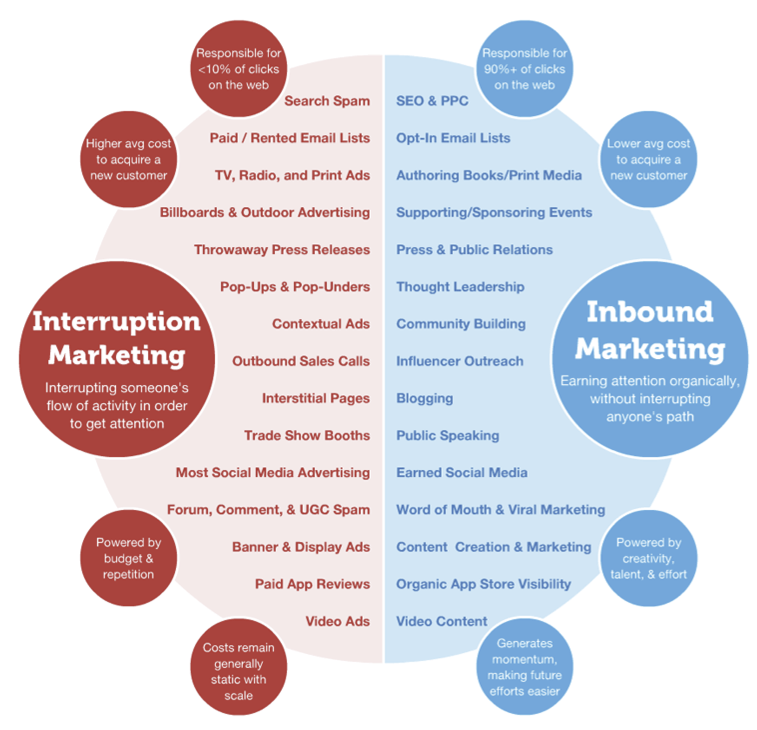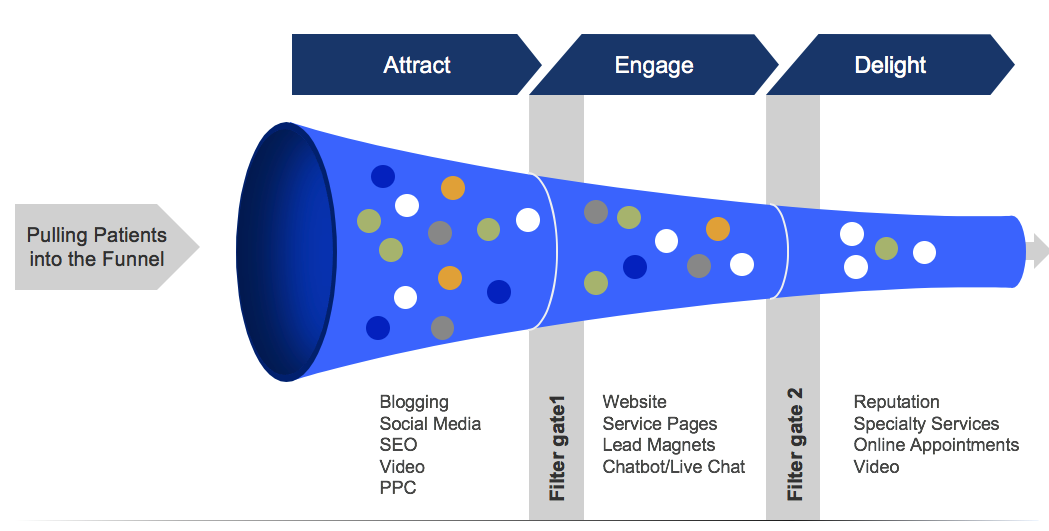There are Two Types of Physical Therapy Marketing: Inbound & Outbound Marketing. This is Part 1 of my 4-part series: The 3 Steps of Inbound to Boost Your Physical Therapy Reputation and Build Confidence in Your Community
Marketing strategies for your private physical therapy practice can be categorized in a number of different ways, but the two primary groups you’re likely to hear more about than any others are inbound vs. outbound. These terms relate to the main direction that your message is being sent, and can be defined as follows:
- Inbound marketing: any tactic that attracts readers and draws them in to your practice; this includes social media posts, opt-in emails, search engine optimization (SEO), blogs, and other types of website content.
- Outbound marketing: any tactic that is directly sent out to a wider audience, including referring physicians, current/past patients, and patient prospects; social media advertising, print advertising, newsletters for referring physicians, and other types of outreach all fall under this category.
Moz created a good graphic that contrasts inbound versus outbound marketing:

Source: Moz
More on Inbound Marketing
Inbound marketing, or “pull marketing,” is all about executing smart strategies that will lead individuals who may be in need of physical therapy to your practice’s website or social media page. Once they’ve found you, the goal is to keep them there long enough to show who you are, what you’re all about, and why you have the solutions to their problems—even if they aren’t necessarily looking for these solutions. How do you accomplish this? With brilliantly crafted content, of course.
One way to break down your content plan is by following three steps that were originally defined by Hubspot. Those are attract, engage, and delight.
Here’s how:
Step 1 – Attract
Bringing web browsers to you is perhaps the most difficult step, simply due to massive number of pages on the web and sheer improbability that the right person will find your website. This is why it’s absolutely imperative that you utilize SEO strategies for all content hosted on your website. By utilizing smart and specific SEO terms that apply to your target audience—like “physical therapy in Smithville or Springfield physical therapists,” for example—you’ll significantly increase the chances of someone identifying your website when doing a search for those terms.
You should also aim to utilize SEO strategies (i.e. including keywords and links back to your website) in all of your social media posts to help with your search rankings.
Step 2 – Engage
Once someone has made their way to your website or social media page, you need to give them a good reason to stay there. For an individual who has an injury and is looking for a physical therapist specifically, this means showing them what you offer over your competitors and why you’re the best practice in the area for their needs. For a reader who isn’t even aware that physical therapy is right for them, this means highlighting the numerous benefits of therapy that will solve their problems.
Blog posts that describe the wide variety of conditions you treat are essential for engagement, but you should also need to have additional content that conveys your commitment to your community, your authority, and your expertise—like “About Us”, FAQ, and Mission/Vision/Values pages—that tell your story and boosts your reputation.
Step 3 – Delight
If you’ve executed the first two steps successfully and have fully engaged a reader, then he or she may go on to choose your practice and schedule their first appointment. This is great, but it’s not the end of the story. Assuming the patient does begin treatment, you’ll also need to delight them throughout their course of care to keep them engaged in their plan of care, progress, and outcomes.
Targeted emails/SMS messages that patients can opt into are effective at this stage to show patients that you care and want to ensure their experience with you is positive. You can send surveys and newsletters through email that keep the engagement level high and continue to direct your patients to your website and social media platforms, which will reinforce your message and show them they’ve made the right choice. Hosting large volumes of informative content on a variety of topics will also reinforce your position as a trusted authority on physical therapy and general health.
Inbound Marketing – Planting the Seed that You are There for Them, Even if They Aren’t Ready to Use Your PT Services Yet
Inbound marketing can be seen as planting a seed and then waiting for it to sprout, and the better your strategy, the higher the chances this will occur. It offers some advantages over outbound marketing, but we believe it’s most effective to utilize both approaches.
Read our next blog for a closer look at outbound marketing.
If you need help with inbound physical therapy marketing for your practice, simply click here to schedule some time with us.
Reference:
Inbound Marketing by Brian Halligan


Leave a Reply
You must be logged in to post a comment.